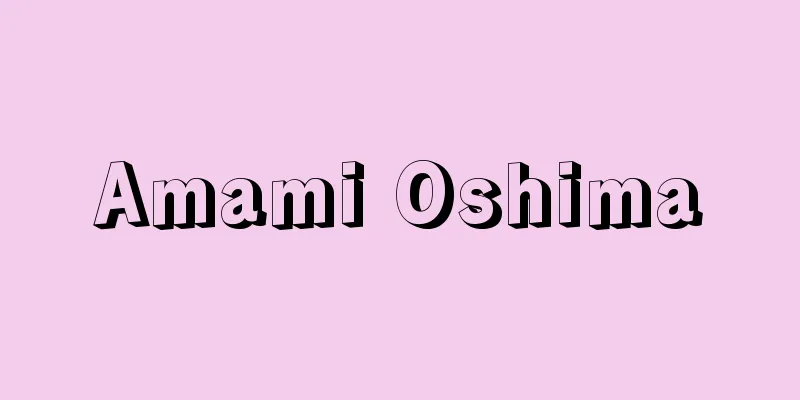Amami Oshima

|
Located at the northern end of the Amami Islands in Kagoshima Prefecture, it is the largest island in the group. Its affiliated islands include Kakeroma Island, Yoro Island, and Ukejima Island. The island has an area of 712.38 square kilometers, and the highest point on the island is Yuwandake at 694 meters. Both the island and Kakeroma Island have ria coastlines that are extremely curved. Due to this topography, with the exception of the Kasari Peninsula in the north, there is no flat lowland, and the entire island can be said to be mountainous. From the northeastern end, the area includes the Kasaricho district of Amami City, Tatsugocho, Naze district of Amami City, Yamato Village, Sumiyoucho district of Amami City, Uken Village, and Setouchi Town, with Setouchi Town including Kakeroma Island, Yoro Island, and Ukejima. Geologically, most of the area is divided into several types of Paleozoic strata that run northeast-southwest, and on top of these, there are small areas of ancient granite and alternating layers of sandstone and shale thought to be from the Paleogene period. The climate is subtropical, with a warm and humid subtropical type, and the average monthly temperature in the coldest month (January) in Naze is 14.8°C, the average annual temperature is 21.6°C, and the annual precipitation is 2,838 mm, making it one of the rainiest areas in Japan. Of course, precipitation from the rainy season and typhoons is high, but the winter precipitation is also high, averaging 160-200 mm per month (averages from 1981 to 2010), which is one of the factors that increase the annual precipitation. Due to these natural conditions, the biota (flora and fauna) is significantly different from that of the mainland and has strong similarities to that of Southeast Asia, and is home to the Amami rabbit, a special natural monument, and the poisonous Habu snake. The history of the Amami Islands, including Amami Oshima, is long and can be traced back to the Nihon Shoki, but the islands only became Japanese territory after Shimazu Iehisa conquered the Ryukyu Islands in 1609 (Keicho 14). The islands continued to be governed by a feudal domain until the Meiji era, and later became Kagoshima Prefecture, where it remains to this day, but for about eight years after World War II, like Okinawa Prefecture, it was under military rule by the US military. It was returned to Japan on December 25, 1953 (Showa 28). The main industries are sugarcane cultivation, the cultivation techniques of which were introduced during the feudal era and have continued ever since, and the production of Oshima Tsumugi silk, with other industries including aquaculture and forestry. In recent years, the island has been focusing on tourism, focusing on natural landscapes such as Kuninao Beach, Yoan Beach, Cape Ayamaru, Yo Beach, and Oshima Strait, as well as annual events such as the August Dance and Amami Festival, traditional performing arts, and traditional houses such as Takakura. Transportation routes on the island are still inadequate due to the mountainous terrain and a lack of social investment after the war, but they are gradually making up for this. The island is connected to Kagoshima City by large liner ships and airplanes, and the Naze district of Amami City is also a transportation hub for the Amami Islands. Population: 65,969 (2009). [Kimihiko Tsukada] plantAmami Oshima has a rich flora with many endemic species, including Amami holly, Amami violet, parasitic bilberry, and Amami salicaria. Natural vegetation is also well developed, with evergreen broadleaf forests dominated by castanopsis, racemosum, and scutellaria (such as the Kehadariminokinawa-Sudajii community), as well as communities of Hadonoki and Hokagehengo, and these virgin forests remain within Kinsakubaru National Forest. In addition, subtropical vegetation such as cycad communities, Pandanus revoluta communities, and Kusatospora communities have developed along the coast. [Shigetoshi Okuda] World Heritage RegistrationIn 2021 (Reiwa 3), Amami Oshima was registered as a Natural World Heritage Site by UNESCO (United Nations Educational, Scientific and Cultural Organization) as "Amami Oshima, Tokunoshima, Northern Okinawa Island and Iriomote Island" (World Natural Heritage Site). [Editorial Department, January 21, 2022] "Amami - Nature and Culture" (1959, Japan Society for the Promotion of Science) ▽ "The Amami Islands" by Shobono Noboru (1965, Amamisha) ▽ "Japanese Geography 21" edited by Aono and Odomegawa (1975, Ninomiya Shoten) ▽ "General Conditions of the Amami Islands" compiled and published by the Oshima Branch Office of Kagoshima Prefecture (various editions) [Reference] |Source: Shogakukan Encyclopedia Nipponica About Encyclopedia Nipponica Information | Legend |
|
鹿児島県奄美諸島の北端に位置し、同諸島中最大の島。属島に加計呂麻島(かけろまじま)、与路島(よろじま)、請島(うけじま)などがある。本島の面積712.38平方キロメートル、島の最高点は湯湾岳(ゆわんだけ)の694メートル。本島と加計呂麻島はリアス式の海岸線を有し、極度に屈曲に富む。このような地形であるため、北部の笠利半島(かさりはんとう)付近を除くと、平坦(へいたん)な低地には恵まれず、島全体が山地といってもよい。北東端から、奄美市笠利町地区、龍郷(たつごう)町、奄美市名瀬(なぜ)地区、大和(やまと)村、奄美市住用(すみよう)町地区、宇検(うけん)村、瀬戸内(せとうち)町と並び、瀬戸内町は加計呂麻島、与路島、請島なども含む。地質学的には、大部分が北東―南西走向の数種の古生層に区分され、これらを基盤としてごく一部に古期花崗(かこう)岩類、古第三紀のものと考えられる砂岩・頁岩(けつがん)互層が分布する。気候は亜熱帯性の温暖湿潤型を示し、名瀬地区の最寒月の月平均気温(1月)が14.8℃、年平均気温は21.6℃、年降水量は2838ミリメートルと日本でも最多雨地域に属している。もちろん、梅雨や台風による降水量は多いが、冬期のそれも月平均160~200ミリメートル(以上、1981~2010年の平均)と多く、これが年降水量を増大させる一因ともなっている。これらの自然的条件の影響で、その生物相(動植物)は本土とは著しく異なり、東南アジアとの類似性が強く、特別天然記念物のアマミノクロウサギや毒蛇のハブも生息する。 奄美大島を含む奄美諸島の歴史は古く、『日本書紀』にまでさかのぼることができるが、この島々が日本領土となったのは、1609年(慶長14)島津家久(しまづいえひさ)による琉球(りゅうきゅう)征服以後である。以後明治時代になるまで藩政が続き、のちに鹿児島県となり現在に至るが、第二次世界大戦後の約8年間は沖縄県と同様アメリカ軍の軍政下に置かれた。日本への復帰は1953年(昭和28)12月25日である。基幹産業は、藩政時代にその栽培技術が伝えられ、以来続いているサトウキビ栽培、および大島紬(つむぎ)の生産で、このほかに水産養殖業、林業などが行われる。近年、国直(くになお)海岸、用安(ようあん)海岸、アヤマル崎、用(よう)海岸、大島海峡などの自然景観、あるいは八月踊り、奄美祭などの年中行事や、伝統芸能、高倉などの民家などを含む観光資源に着目し観光業にも力を入れている。島内の交通路は、山がちな地形や戦後の一時期の社会投資の不足などの原因でいまだ十分とはいえないが、徐々にその遅れを取り戻しつつある。鹿児島市とは大型の定期船や航空機で結ばれ、奄美市名瀬地区は奄美諸島の交通拠点ともなっている。人口6万5969(2009)。 [塚田公彦] 植物奄美大島はフロラ(植物相)が豊かで固有種も多く、アマミヒイラギモチ、アマミスミレ、ヤドリコケモモ、アマミサンショウソウなど、生態的に興味ある種が分布している。自然植生もよく発達し、シイ、イスノキ、イジュなどの優占する常緑広葉樹林(ケハダルリミノキ―スダジイ群集など)やハドノキ―ヒカゲヘゴ群落などが生育し、金作原国有林(きんさくばるこくゆうりん)内にこれらの原生林が残存している。さらにソテツ群落、アダン群集、クサトベラ群落など、亜熱帯性の植生が海岸沿いに発達している。 [奥田重俊] 世界遺産の登録2021年(令和3)、奄美大島はユネスコ(国連教育科学文化機関)により「奄美大島、徳之島、沖縄島北部および西表島(いりおもてじま)」として世界遺産の自然遺産に登録された(世界自然遺産)。 [編集部 2022年1月21日] 『『奄美――自然と文化』(1959・日本学術振興会)』▽『昇曙夢著『奄美の島々』(1965・奄美社)』▽『青野・尾留川編『日本地誌 21』(1975・二宮書店)』▽『鹿児島県大島支庁編・刊『奄美群島の概況』(各年版)』 [参照項目] |出典 小学館 日本大百科全書(ニッポニカ)日本大百科全書(ニッポニカ)について 情報 | 凡例 |
Recommend
Ranaishikawae (English spelling)
… [Takahiro Matsui]. … *Some of the terminology t...
Family estate - Keryō
〘 noun 〙 A territory or manor handed down to a fam...
Drepanocladus fluitans (English spelling) Drepanocladusfluitans
...In Lake Inawashiro, the moss Jungermannia nipp...
Station system
Transportation system under the Ritsuryo system: P...
Hired bus service - Kashikiri Bus (English name)
A bus that charters transportation by vehicle acco...
Olygosuccharide
…Most of them have the molecular formula (CH 2 O)...
Absorption chromatography
…[Nursery teacher Toshiyuki]. … *Some of the term...
Acrylic rubber
A general term for synthetic rubber whose main co...
Pastorella
…The final movement of Corelli's Christmas Co...
Nishimeya [village] - Nishimeya
A village in Nakatsugaru district, southwest of Ao...
Bubalornithinae
…This family is a relatively well-organized group...
Pomponius Gauricus
…Artists of the time, in particular, studied phys...
Collar - Kinshi
A genius. See the entry for "collar" in ...
Chanchin - Chanchin
A deciduous tall tree of the Meliaceae family (AP...
Jurisdiction - Jurisdiction
The power that a country's courts can exercise...






![Morita [village] - Morita](/upload/images/67cd06ce96ca6.webp)


